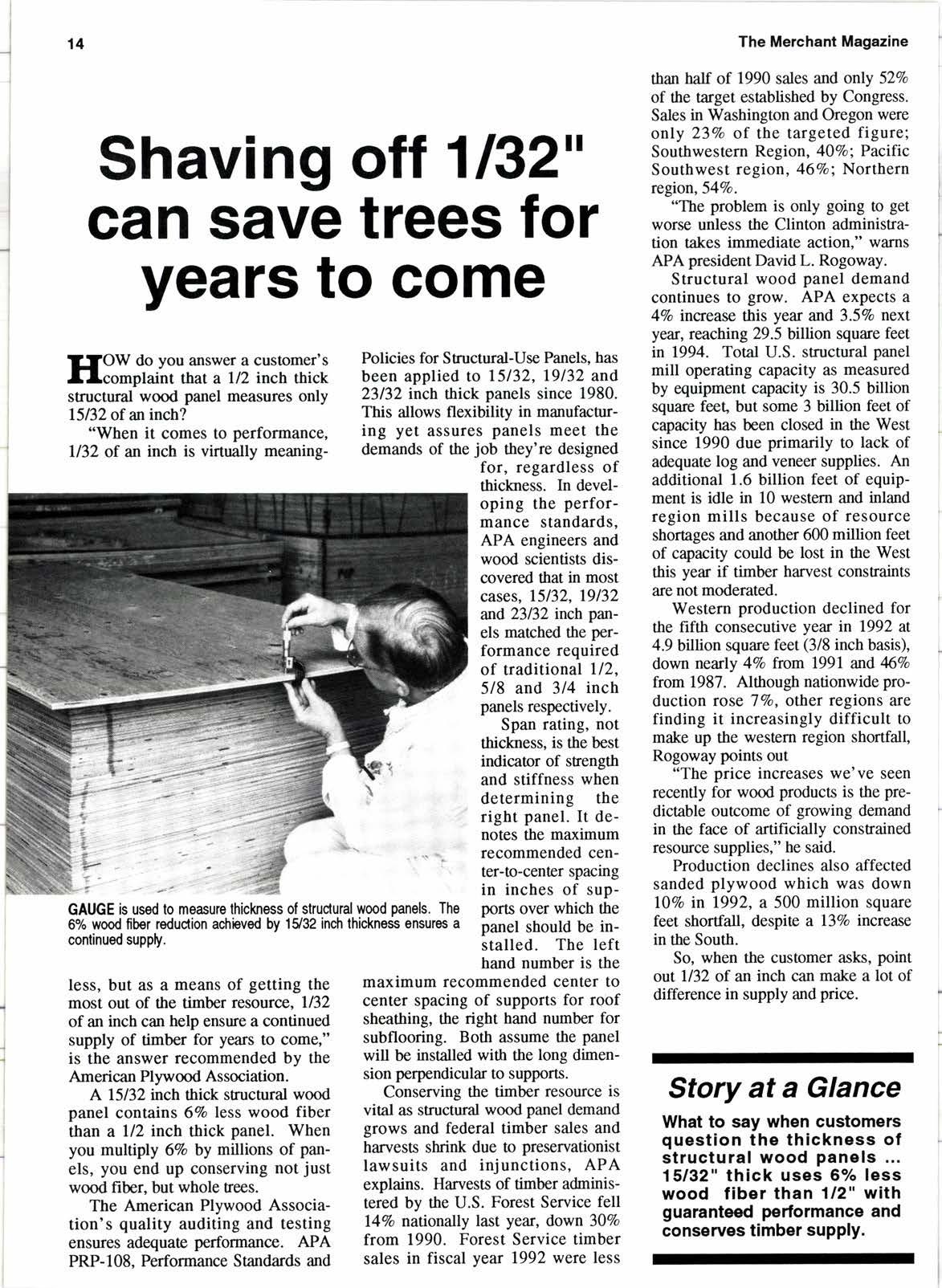
2 minute read
Shaving off 1132" can save trees for years to come
trtrOW do you answer a customer's Ilcomplaint that a 1/2 inch thick structural wood panel measures only 15R2 of an inch?
"When it comes to performance, ll32 of an inch is virtually meaning- than half of 1990 sales and only 52Vo of the target established by congress. Sales in Washington and Oregon were only 23Vo of the targeted figure; Soutlwestern Region, 40Vo; Pacifrc Southwest region, 467o; Northern rcgion,54Vo. less, but as a means of getting the most out of the timber resource, 1/32 of an inch can help ensure a continued supply of timber for years to come," is the answer recommended by the American Plywood Association.
Policies for Structural-Use Panels, has been applied to 15132, 19132 and 23132 inch thick panels since 1980. This allows flexibility in manufacnring yet assures panels meet the demands of the job they're designed for, regardless of thiclness. In developing the performance standards, APA engineers and wood scientists discovered that in most cases, 15/32, 19132 and 23132 inch panels marched the performance required of traditional l12, 5/8 and 3/4 inch panels respectively.
"The problem is only going to get worse unless the Clinton administration takes immediate action," warns APA president David L. Rogoway.
Structural wood panel demand continues to grow. APA expects a 4Vo inqeaw this year and 3.5Vo next year, reaching 29.5 billion square feet in 1994. Total U.S. structural panel mill operating capacity as measured by equipment capacity is 30.5 billion squarc feet, but some 3 billion feet of capacity has been closed in the West since 1990 due primarily to lack of adequate log and veneer supplies. An additional 1.6 billion feet of equipment is idle in 10 westem and inland region mills because of resource shortages and another 600 milton feet of capacity could be lost in the West this year if timber harvest consEaints are not noderated.
A 15132 inch thick structural wood panel contains 6Vo less wood fiber than a ll2 inch thick panel. When you multiply 6Vo by millions of panels, you end up conserving not just wood fiber, but whole trees.
The American Plywood Association's quality auditing and testing ensures adequate performance. APA PRP-108, Perfonnance Standards and
Span rating, not thiclness, is the best indicator of strength and stiffness wben determining the right panel. It denotes the maximum recommended center-to-center spacing in inches of supports over which the panel should be installed. The left hand number is the maximum recommended center to center spacing of supports for rqof sheathing, the right hand number for subflooring. Both assume the panel will be installed with the long dimension perpendicular to supports.
Conserving the timber resource is vital as structural wood panel demand grows and federal timber sales and harvests sbrink due to preservationist lawsuits and injunctions, APA explains. Harvests of timber administered by the U.S. Forest Service fell l4%o nattonally last year, down 30Vo from 1990. Forest Service timber sales in fiscal year 1992 were less
Western production declined for the fifth consecutive year in 1992 at 4.9 billion square feet (3/8 inch basis), down nearly 4Vo ftom l99l and 46Vo from 1987. Although nationwide production rose 7Vo, other regions are finding it increasingly difficult to make up the western region shortfall, Rogoway points out
"The price increases we've seen recently for wood products is the predictable outcome of growing demand in the face of artificially constained resource supplies," he said.
Production declines also affected sanded plywood which was down llVo in 1992, a 500 million square feet shorfall, despite a l3Vo increase in the South.
So, when the customer asks, point out ll32 of an inch can make a lot of difference in supply and price.
Story at a Glance
What to say when customers question the thickness of structural wood panels 15132" thick uses 67o less wood fiber than 1/2" with guaranteed performance and conssrves timber supply.
I










